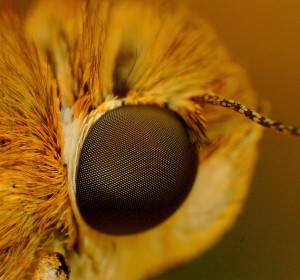|
You can see the moiré pattern in the eye of this moth. This is the result of downsizing an image with fine detail. |
Anti-Aliasing (AA) filters are both good and bad. The purpose of an AA filter is to reduce the effects of moiré patterns. These patterns are an unwanted result of digital imaging. Moiré patterns typically appear when photographing clothes or other material with very fine detail. The pixels in the sensor and the fine detail of the scene interfere with one another resulting in unnatural patterns that do not actually exist. One effect can be a series of curved lines even though the scene may contain completely straight lines. Moiré patterns can also appear when downsizing an image. These patterns are very distracting and photo publishers and stock photo agencies alike know to look out for moiré and will not accept any photos that have it. This is where the AA filter comes in. Anti-aliasing is a method by which moiré patterns are reduced. In digital photography, AA filters have been built-in for this purpose. They work by slightly dispersing the incoming light and filling in neighboring pixels so that the lines in these sharp patterns are muted and become much less defined, and they often disappear. Since most every digital camera has an AA filter, you may have never heard of this moiré pattern effect. But if these cameras didn't have AA filters, you would be seeing these patterns everywhere. |
Recommended Cameras:
Nikon D500 | Nikon D3300 | Canon EOS Rebel T5 | Sony A7RII | Canon 7D Mark II
Of course, with every pro comes a con. The bad things about AA filters is that they reduce the sharpness of your photo every so slightly. The camera can not filter out what parts of the scene are creating moiré patterns and which are not, so it can't selectively fix those areas. Instead it affects the whole image meaning that you will lose some detail due to the blurring effects of the AA filter. So while fixing the unwanted parts of the image, it also affects those that don't need to be fixed also.
Different camera models will have different AA filters. Some are very strong and some are weak. Many photographers believe that the weak filters are better because they blur the image less, however, their effect on moiré is less defined.
Perhaps one of the biggest problems with moiré is that it cannot be easily fixed during post-processing. There are several software programs available that have different algorithms for compensating for moiré, but since the patterns are so random these tools may not be able to fix the problem in every scene.
What about removing the AA filter you say? Well, this actually can be done, and there are a few companies that you can send your camera into to have it removed. Up until recently, almost every digital camera came with a built-in AA filter, but this is starting to change. When the Nikon D800 was release it came in two versions: The regular D800 and the D800E. They are exactly the same except that the 800E does not have a traditional AA filter which means no blurring of the image. This filter is also not present in the new Nikon D7100. Just remember that, even though your optical resolution will increase, once this filter is taken out it will be difficult to remove any moiré problems you come across.
Recommended Reading:
- 2013 Photographer's Market: The Most Trusted Guide to Selling Your Photography
- Best Business Practices for Photographers
- The Fast Track Photographer Business Plan: Build a Successful Photography Venture from the Ground Up
- Group Portrait Photography Handbook
- The Best of Family Portrait Photography: Professional Techniques and Images
- 500 Poses for Photographing Group PortraitsSelling Your Photography: How to Make Money in New and Traditional Markets
- Starting Your Career as a Freelance Photographer
- Photographer's Survival Manual: A Legal Guide for Artists in the Digital Age
- Legal Handbook for Photographers: The Rights and Liabilities of Making Images
- Taking Stock: Make money in microstock creating photos that sell
- Going Pro: How to Make the Leap from Aspiring to Professional Photographer
Article and photo by Spencer Seastrom

